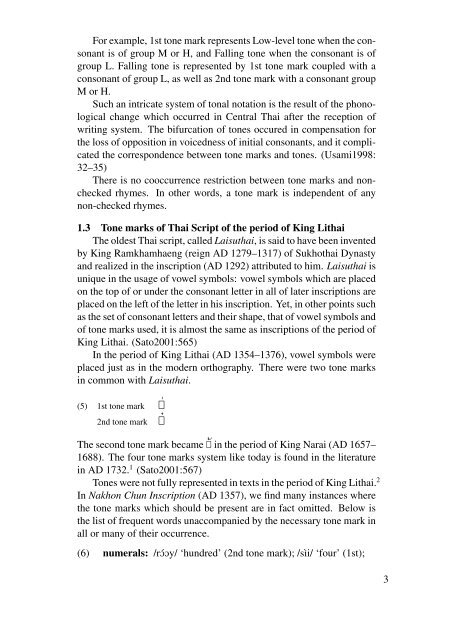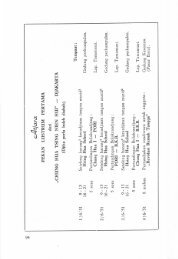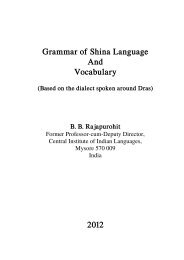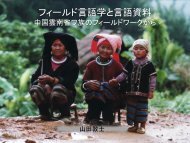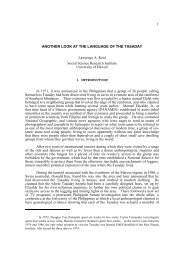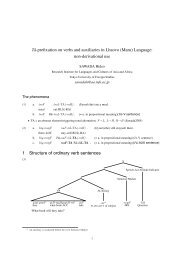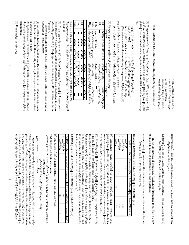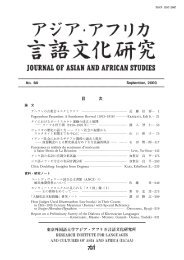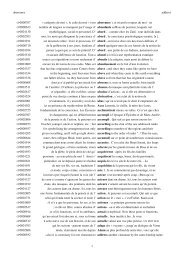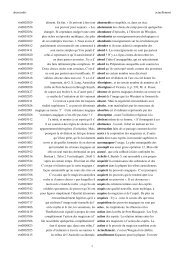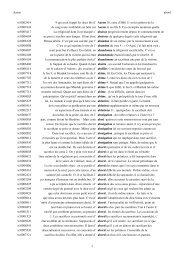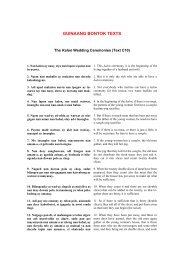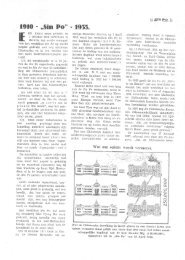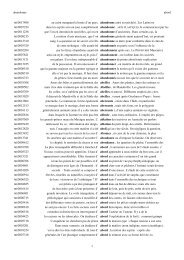Tonal Notation of Indic scripts in Mainland Southeast Asia
Tonal Notation of Indic scripts in Mainland Southeast Asia
Tonal Notation of Indic scripts in Mainland Southeast Asia
You also want an ePaper? Increase the reach of your titles
YUMPU automatically turns print PDFs into web optimized ePapers that Google loves.
For example, 1st tone mark represents Low-level tone when the consonant<br />
is <strong>of</strong> group M or H, and Fall<strong>in</strong>g tone when the consonant is <strong>of</strong><br />
group L. Fall<strong>in</strong>g tone is represented by 1st tone mark coupled with a<br />
consonant <strong>of</strong> group L, as well as 2nd tone mark with a consonant group<br />
M or H.<br />
Such an <strong>in</strong>tricate system <strong>of</strong> tonal notation is the result <strong>of</strong> the phonological<br />
change which occurred <strong>in</strong> Central Thai after the reception <strong>of</strong><br />
writ<strong>in</strong>g system. The bifurcation <strong>of</strong> tones occured <strong>in</strong> compensation for<br />
the loss <strong>of</strong> opposition <strong>in</strong> voicedness <strong>of</strong> <strong>in</strong>itial consonants, and it complicated<br />
the correspondence between tone marks and tones. (Usami1998:<br />
32–35)<br />
There is no cooccurrence restriction between tone marks and nonchecked<br />
rhymes. In other words, a tone mark is <strong>in</strong>dependent <strong>of</strong> any<br />
non-checked rhymes.<br />
1.3 Tone marks <strong>of</strong> Thai Script <strong>of</strong> the period <strong>of</strong> K<strong>in</strong>g Lithai<br />
The oldest Thai script, called Laisuthai, is said to have been <strong>in</strong>vented<br />
by K<strong>in</strong>g Ramkhamhaeng (reign AD 1279–1317) <strong>of</strong> Sukhothai Dynasty<br />
and realized <strong>in</strong> the <strong>in</strong>scription (AD 1292) attributed to him. Laisuthai is<br />
unique <strong>in</strong> the usage <strong>of</strong> vowel symbols: vowel symbols which are placed<br />
on the top <strong>of</strong> or under the consonant letter <strong>in</strong> all <strong>of</strong> later <strong>in</strong>scriptions are<br />
placed on the left <strong>of</strong> the letter <strong>in</strong> his <strong>in</strong>scription. Yet, <strong>in</strong> other po<strong>in</strong>ts such<br />
as the set <strong>of</strong> consonant letters and their shape, that <strong>of</strong> vowel symbols and<br />
<strong>of</strong> tone marks used, it is almost the same as <strong>in</strong>scriptions <strong>of</strong> the period <strong>of</strong><br />
K<strong>in</strong>g Lithai. (Sato2001:565)<br />
In the period <strong>of</strong> K<strong>in</strong>g Lithai (AD 1354–1376), vowel symbols were<br />
placed just as <strong>in</strong> the modern orthography. There were two tone marks<br />
<strong>in</strong> common with Laisuthai.<br />
(5) 1st tone mark Că<br />
2nd tone mark Cľ<br />
The second tone mark became Cč <strong>in</strong> the period <strong>of</strong> K<strong>in</strong>g Narai (AD 1657–<br />
1688). The four tone marks system like today is found <strong>in</strong> the literature<br />
<strong>in</strong> AD 1732. 1 (Sato2001:567)<br />
Tones were not fully represented <strong>in</strong> texts <strong>in</strong> the period <strong>of</strong> K<strong>in</strong>g Lithai. 2<br />
In Nakhon Chun Inscription (AD 1357), we f<strong>in</strong>d many <strong>in</strong>stances where<br />
the tone marks which should be present are <strong>in</strong> fact omitted. Below is<br />
the list <strong>of</strong> frequent words unaccompanied by the necessary tone mark <strong>in</strong><br />
all or many <strong>of</strong> their occurrence.<br />
(6) numerals: /rÓOy/ ‘hundred’ (2nd tone mark); /sìi/ ‘four’ (1st);<br />
3


